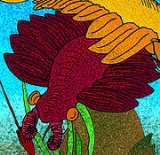
Amplectobelua
Encyclopedia
Amplectobelua is an extinct genus of anomalocaridid, a group of very early marine animals. While completely different from any animal alive today, some scientists do believe that the very primitive anomalocarids were in fact somewhat related to arthropods. They are placed in their own taxon, the Dinocarida
, which they may share with the five-eyed Opabinia
, another extremely odd-looking Cambrian
marine animal. The genus is represented by a species in each of the Chengjiang and Burgess Shale
deposits.
Compared to other anomalocarids, Amplectobelua is smaller and more compact (although still much bigger than most, if not all other animals of its time). It had big eyes, which were positioned laterally of the mouth, and several extended lobes on both sides of its segmented body, used for swimming. It had a pair long, feeler-like cerci that extended from the posterior end of the body, and two claw-like appendages on the front of its face. The latter were probably used to capture prey and deliver it to Amplectobeluas mouth, located at the bottom of its face.
Dinocarida
DinocarididaGreek, "Terrible crabs" – sometimes informally spelt Dinocarida, but the second 'id' is linguistically correct – see is a proposed extinct taxon of fossil arthropod-like marine animals found in the early and middle Cambrian. It is subdivided into the anomalocarids and the opabinids...
, which they may share with the five-eyed Opabinia
Opabinia
Opabinia is an animal genus found in Cambrian fossil deposits. Its sole species, Opabinia regalis, is known from the Middle Cambrian Burgess Shale of British Columbia, Canada. Fewer than twenty good specimens have been described; 3 specimens of Opabinia are known from the Greater Phyllopod bed,...
, another extremely odd-looking Cambrian
Cambrian
The Cambrian is the first geological period of the Paleozoic Era, lasting from Mya ; it is succeeded by the Ordovician. Its subdivisions, and indeed its base, are somewhat in flux. The period was established by Adam Sedgwick, who named it after Cambria, the Latin name for Wales, where Britain's...
marine animal. The genus is represented by a species in each of the Chengjiang and Burgess Shale
Burgess Shale
The Burgess Shale Formation, located in the Canadian Rockies of British Columbia, is one of the world's most celebrated fossil fields, and the best of its kind. It is famous for the exceptional preservation of the soft parts of its fossils...
deposits.
Compared to other anomalocarids, Amplectobelua is smaller and more compact (although still much bigger than most, if not all other animals of its time). It had big eyes, which were positioned laterally of the mouth, and several extended lobes on both sides of its segmented body, used for swimming. It had a pair long, feeler-like cerci that extended from the posterior end of the body, and two claw-like appendages on the front of its face. The latter were probably used to capture prey and deliver it to Amplectobeluas mouth, located at the bottom of its face.

